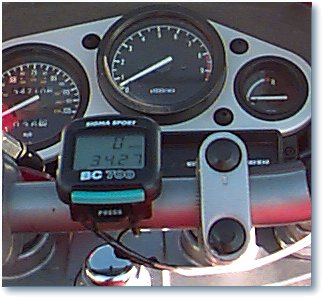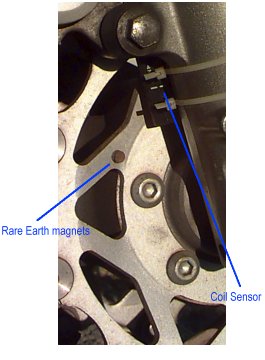
|
This whole idea may seem absurd, but here's the problem. Motorcycle
speedometers are notoriously inaccurate. Many believe that they are designed
to read fast. They would rather you believe that you're going faster
than you really are. How bad is the problem? Well, my speedometer is about 10 percent fast, and from talking to other people, that is not abnormal. That means that when my speedometer is reading 55mph, I'm actually only going 49.5mph and if I were to run it up to an indicated 130, I'd only be going 117mph. But there is a solution. Most, if not all, bicycle computers sold today can be calibrated using the circumfrence of the tire with accuracy down to the millimeter. To figure this out, you simply make a mark on the tire and the ground under it, and then roll the tire out once or twice while sitting on the bike, make the second mark on the ground and measure the distance and divide by the number of revolutions. Now this is all well and good, except you might be asking at this point, "Do bicycle computers really go that fast?." Well actually, most don't, but a couple do. The one I chose is the SIGMA Sport 700. It is accurate up to 170mph and has the following features:
The only oddity is, that while it can change the display from kph to mph, it doesn't automatically change the calculations internally to match. Therefore for the numbers to actually read in miles and mph you have to divide the circumfrence as measured in millimeters, by 1.6. And here it is mounted on the bike: |

|
The tricky bit was figuring out what to do about the sensor and magnet.
Normally the sensor would be mounted on a small bicycle fork and the magnet
would attach to one of the spokes. I tucked the sensor on the back of the
fork underneath the brake calipers. The magnet that came with the unit simply
would not be usable, so I went to Radio Shack and picked up what they
call "Rare Earth Magnets".
 These are two tiny tiny magnets, about 3/16" in
diameter and 1/16" thick. I just dabbed a little
metal epoxy on the back of one and stuck it to the hub of the brake rotor.
I then just stuck (sans glue) the second magnet on top of that. They're
so powerful that the second magnet will not fly off at any speed I can
reach. I didn't glue it, because I'd rather it come off than get caught on
something if the sensor ever slipped.
These are two tiny tiny magnets, about 3/16" in
diameter and 1/16" thick. I just dabbed a little
metal epoxy on the back of one and stuck it to the hub of the brake rotor.
I then just stuck (sans glue) the second magnet on top of that. They're
so powerful that the second magnet will not fly off at any speed I can
reach. I didn't glue it, because I'd rather it come off than get caught on
something if the sensor ever slipped.
The whole setup works great and is super accurate. I've tested it up to 120mph without any problem. It was somewhat depressing to find out that my odometer is also fast and thus I'm not really getting as good of gas mileage as I thought. Now if I could just see the damn thing at night.. ;-) Here's someone else with the same idea and some pretty detailed mounting instructions. And another one with some information on the difference between the BC700 and BC800. |